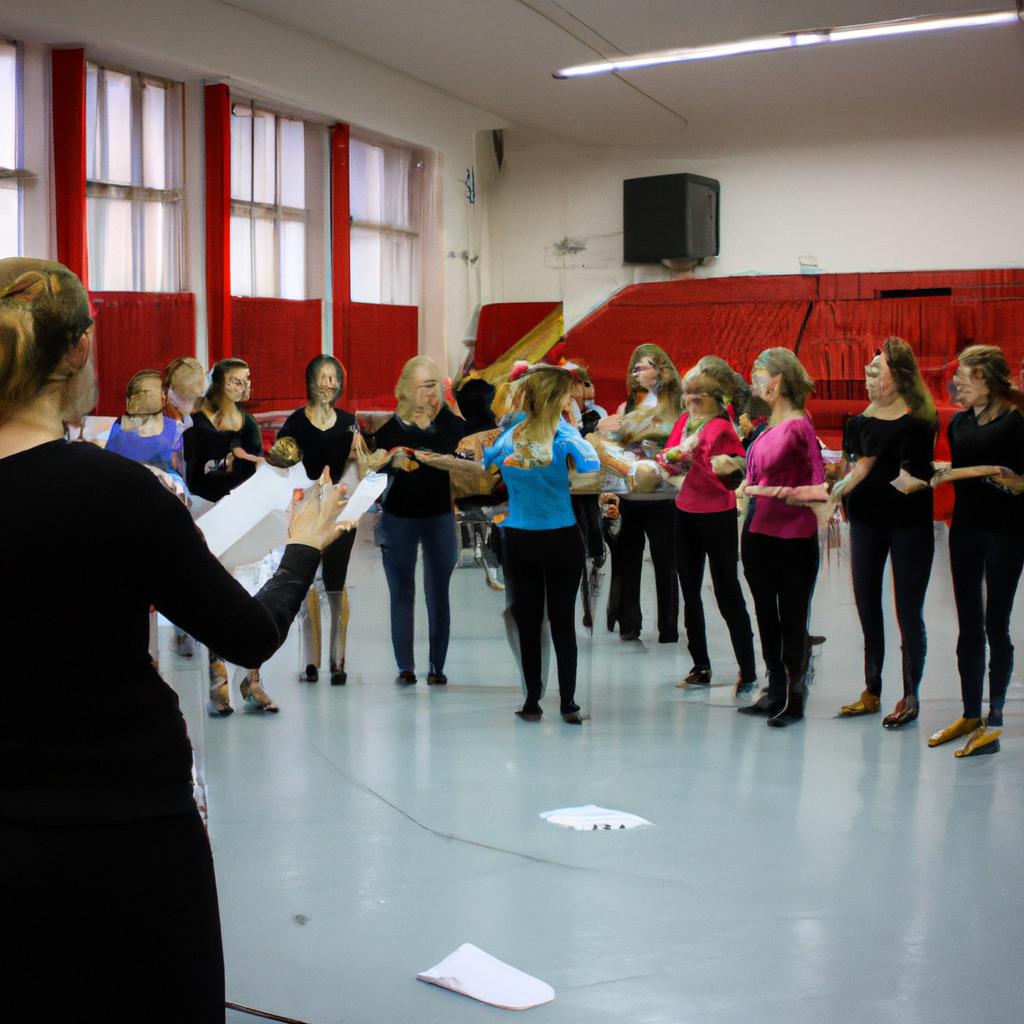In the realm of vocal ensemble performance, achieving optimal vocal resonance and diction is crucial for a captivating and impactful musical experience. The interplay between these two elements can greatly enhance the overall quality of choral performances, allowing singers to project their voices effectively while conveying the intended meaning of the text or lyrics. For instance, let us consider a hypothetical scenario where an amateur choir attempts to perform a complex piece with intricate harmonies and dynamic contrasts. Despite possessing talented individuals within its ranks, the lack of proper understanding and application of vocal resonance and diction may lead to a muddled sound that fails to engage the audience fully. Hence, it becomes imperative for vocal ensembles to possess comprehensive knowledge about vocal resonance and diction in order to elevate their performances.
Vocal resonance refers to the amplification and enrichment of sound produced by vibrations in various cavities within our bodies during singing. It involves harnessing the natural resonating spaces such as the chest, throat, mouth, and nasal passages to create a vibrant tone that carries well in large performance venues. Properly developed vocal resonance enables singers to achieve clarity, projection, and tonal richness without straining their voices excessively. However, this aspect often proves challenging for many performers due to factors such as poor posture , lack of breath support, tension in the vocal muscles, or incorrect placement of the sound.
To develop optimal vocal resonance, singers should focus on a few key areas. Firstly, maintaining good posture is crucial as it helps to align the body and allows for proper breath control. This involves keeping the spine straight, shoulders relaxed, and head balanced on top of the spine. By doing so, singers can ensure that their airflow is unrestricted and can resonate freely within their bodies.
Secondly, breath support plays a vital role in achieving vocal resonance. Singers should learn how to engage their diaphragm and abdominal muscles to control the flow of air during singing. This controlled airflow not only provides stability but also creates a strong foundation for resonant singing.
Furthermore, understanding vocal placement is essential for optimizing resonance. Different sounds require different placements within the vocal tract. Exploring various vowel shapes and experimenting with different mouth positions can help singers find their ideal placement for producing resonant tones.
Moving on to diction, it refers to the clarity and articulation of words while singing. Effective diction ensures that lyrics are understood by the audience and conveys the intended message of the song accurately. Proper diction involves precise pronunciation of consonants and vowels without sacrificing vocal quality or musicality.
To improve diction in choral performances, ensembles can work on several aspects. First and foremost is understanding and practicing correct pronunciation of words in different languages or dialects if required by the repertoire. Paying attention to specific language nuances and using appropriate vowel modifications or consonant formations can greatly enhance clarity.
Additionally, focusing on consonant precision is crucial for clear diction. Consonants should be articulated crisply without interrupting the flow of sound or creating excessive tension in the voice. Developing coordination between tongue placement and jaw movement can aid in achieving accurate consonant production.
Finally, balancing consonants with vowels is important to maintain a smooth legato line while still articulating the words clearly. Finding the right balance between consonant clarity and vowel resonance ensures that the text remains intelligible without sacrificing vocal beauty.
In summary, achieving optimal vocal resonance and diction in choral performances is a multifaceted endeavor involving proper posture, breath support, vocal placement, language understanding, and precision in consonant and vowel production. By paying attention to these elements, singers can elevate their performances and create an engaging musical experience for both themselves and their audience.
Understanding Vocal Resonance
Vocal resonance is a fundamental aspect of vocal ensemble performance, playing a crucial role in creating rich and vibrant harmonies. It refers to the amplification and modification of sound produced by the vocal cords through various resonating structures in the body. By understanding how vocal resonance works, singers can harness its power to enhance their diction and overall vocal quality.
To illustrate this concept, let us consider an example: Imagine a tenor singer performing in a choral setting. As he sings his part, his voice travels from his vocal cords through his throat, mouth, and nasal cavities before reaching the audience’s ears. Each of these resonating structures affects the tone and clarity of the sound produced. Understanding how to utilize these resonating spaces effectively allows the tenor singer to project his voice with precision and nuance.
To further explore the importance of vocal resonance in achieving optimal singing performance, we can delve into four key factors that influence it:
- Shape and size of resonating spaces: The shape and size of our throat, mouth, and nasal cavities impact how sound waves resonate within them. A wider space may produce a warmer tone, while a narrower space could result in a brighter or more focused sound.
- Placement of articulators: Proper placement of tongue, jaw, lips, and soft palate plays a significant role in shaping vowels and consonants. Accurate positioning helps create clear enunciation for improved diction.
- Breath support: Adequate breath support provides stability for proper control over airflow during phonation. This enables singers to maintain consistent volume levels throughout their range.
- Articulation techniques: Different articulation techniques such as legato (smooth), staccato (short and detached), or marcato (accented) affect resonation patterns. Skillful execution enhances expressiveness and musicality.
By focusing on these aspects within each section mentioned above:
| Aspect | Influence on Resonance | Benefits |
|---|---|---|
| Shape and size of spaces | Tone quality | Richness |
| Placement of articulators | Diction | Clarity |
| Breath support | Control over volume | Consistency |
| Articulation techniques | Expressiveness | Musicality |
In summary, understanding vocal resonance is pivotal for singers in a vocal ensemble. It allows them to optimize their sound production by utilizing resonating structures effectively. By considering the shape and size of these spaces, correct placement of articulators, adequate breath support, and employing various articulation techniques, singers can enhance their diction and produce harmonious performances.
Moving forward into the subsequent section about “The Importance of Proper Breath Support,” we will explore how this essential element interconnects with vocal resonance to further elevate singing abilities.
The Importance of Proper Breath Support
Building upon the understanding of vocal resonance, it is crucial to recognize the significant role that proper breath support plays in achieving optimal vocal production. Consider the following scenario: imagine a vocalist performing a challenging aria with intricate melodic lines and demanding vocal range. Without sufficient breath support, their voice may lack power, control, and stamina, ultimately hindering their ability to deliver a captivating performance.
Paragraph 1:
To comprehend the importance of proper breath support, one must first understand its impact on vocal technique. When a singer takes a deep breath using diaphragmatic breathing, they engage the muscles surrounding the diaphragm and lower abdomen. This action allows for an increased supply of air to enter the lungs, providing ample fuel for sustained phonation and dynamic variation throughout a musical phrase. By utilizing this technique effectively, singers can achieve long phrases without sacrificing tonal quality or pitch accuracy.
Paragraph 2:
Proper breath support offers numerous benefits to vocal ensemble performers:
- Enhances overall volume projection and audibility.
- Facilitates precise intonation and vowel formation.
- Enables seamless legato phrasing.
- Promotes efficient energy management during extended singing sessions.
Paragraph 3:
Incorporate Table:
| Benefits of Proper Breath Support |
|---|
| Improved Vocal Control |
| Enhanced Resonance |
| Increased Stamina |
| Heightened Artistic Expression |
By implementing correct breathing techniques regularly, musicians can unlock their full potential as vocalists within an ensemble setting. They not only experience improved technical proficiency but also develop greater confidence in navigating complex choral arrangements while maintaining consistent tone quality.
With a solid foundation in understanding both vocal resonance and proper breath support well-established, we now turn our attention towards developing clear articulation—a fundamental aspect necessary for effective communication in any vocal ensemble context.
Developing Clear Articulation
Having established the significance of proper breath support in vocal ensemble performance, it is equally essential to focus on developing clear articulation. Effective communication through precise pronunciation and enunciation enhances the overall quality of a vocal ensemble’s performance. By mastering clear articulation techniques, singers can ensure their words are understood effortlessly by both fellow performers and audience members.
Paragraph 1:
To illustrate the impact of clear articulation, consider an example where a choir performs a complex choral piece with intricate harmonies and dynamic contrasts. Despite having impeccable breath support, if the individual syllables within each word are not articulated clearly, the intended musical message may be lost. Clarity in articulation allows for seamless blend and synchronization among voices, creating a cohesive sound that captivates listeners.
Paragraph 2:
There are several strategies that vocalists can employ to improve their articulation skills:
- Consistent tongue placement: Maintaining consistent tongue placement helps produce accurate consonant sounds such as “t,” “d,” or “s.” Practicing exercises that specifically target these sounds can enhance clarity in speech and singing.
- Precision in vowel formation: Paying attention to vowel formation ensures that each vowel is shaped correctly, allowing for optimal resonance and intelligibility. Exercises focusing on pure vowels aid in refining this aspect of articulation.
- Diction drills: Regularly practicing diction exercises strengthens mouth muscles responsible for shaping different sounds. Focusing on specific phonemes enables singers to articulate words more precisely.
- Attention to consonants at phrase endings: Being mindful of consonants at the end of phrases avoids premature cutoffs or muffled endings. Emphasizing these final consonants enhances overall clarity and comprehension.
Bullet Point List (evoking emotional response):
The benefits of developing clear articulation include:
- Enhanced expressiveness: Precise articulation allows singers to convey emotions effectively through nuanced delivery of lyrics.
- Improved audience engagement: Clear articulation ensures that listeners can follow the narrative or message conveyed by the music, enhancing their overall experience.
- Heightened musicality: Articulating each word precisely contributes to a polished and professional performance, elevating the artistic value of the vocal ensemble.
- Strengthened ensemble cohesion: When every member focuses on clear articulation, it fosters unity among performers, resulting in a more impactful collective sound.
Paragraph 3:
Incorporating these techniques into regular vocal warm-up exercises and rehearsal routines will significantly enhance an ensemble’s ability to articulate clearly. By prioritizing this aspect of vocal technique, singers can elevate their performances from mere recitation of lyrics to captivating storytelling through song.
With clear articulation established as a fundamental skill for vocal ensemble excellence, attention must now be directed towards mastering another crucial element – vocal projection. This next step allows singers to project their voices effectively across various performance spaces without strain or compromise in clarity.
Mastering Vocal Projection
Building upon the foundation of clear articulation, developing mastery over vocal projection is essential for singers to effectively convey their message. By understanding how to optimize resonance and diction within a vocal ensemble, performers can captivate audiences with their powerful and expressive voices.
Section – Mastering Vocal Projection:
Imagine a choir performing an uplifting choral piece in a grand cathedral. As they sing, their harmonies soar through the space, filling every nook and cranny with rich tones that resonate deep within the audience’s hearts. This captivating scene exemplifies the importance of mastering vocal projection in creating impactful musical experiences. To achieve such compelling performances consistently, singers must consider several key factors:
- Proper breath support: Effective vocal projection begins with adequate breath control. Singers need to develop techniques that allow them to harness sufficient air supply while maintaining control over its release throughout each phrase.
- Resonant placement: Understanding how different resonating spaces within the body contribute to sound production is crucial. Singers should explore resonance exercises targeting the chest, nasal cavities, and head to maximize tonal richness and clarity.
- Dynamic range management: Learning how to navigate between soft pianissimos and powerful fortissimos without sacrificing quality or straining the voice is fundamental. Vocalists must practice controlled transitions between various dynamic levels while preserving resonance and diction.
- Articulatory precision: Clear diction enhances both the intelligibility and emotional impact of lyrics. Focusing on precise consonant formation allows singers to articulate words clearly even amidst complex harmonies.
Emotional Bullet Point List (markdown format):
- Amplify your voice’s authority through masterful projection.
- Engage listeners by enveloping them in a world of vibrant sound.
- Convey the passion and emotion behind lyrics with powerful resonance.
- Create a lasting impact by delivering crystal-clear diction.
Table (markdown format):
| Vocal Projection Tips |
|---|
| Focus on breath support for sustained power. |
| Explore resonant placements to enhance tonal richness. |
| Master transitions between dynamic levels without strain. |
| Cultivate articulate consonant formation for clear diction. |
By mastering vocal projection, singers can unlock their true potential in commanding attention and captivating audiences. As we delve into our next section on enhancing vocal blend in ensemble singing, we will explore how individual voices intertwine harmoniously to create a unified sonic tapestry that is greater than the sum of its parts.
Enhancing Vocal Blend in Ensemble Singing
Having discussed the importance of mastering vocal projection, we now turn our attention to another crucial aspect of vocal ensemble performance – enhancing vocal blend through effective resonance and diction. The ability to achieve a harmonious balance among voices is essential for creating a unified sound that captivates audiences. By exploring various techniques and exercises related to vocal resonance and diction, singers can optimize their collective impact as an ensemble.
To illustrate the significance of this topic, let us consider a hypothetical scenario where an amateur choir struggles with achieving cohesive blending during rehearsals. Despite individual talents within the group, their performances lack unity due to inconsistent resonance and unclear diction. Addressing these challenges requires focused attention on specific areas:
-
Breath Support: Developing proper breath support plays a vital role in enhancing vocal resonance. Singers must learn to engage their diaphragm effectively, allowing for sustained notes without strain or wavering pitch. Engaging in regular breathing exercises helps strengthen respiratory muscles while promoting controlled airflow conducive to rich tonal quality.
-
Vowel Formation: Clear vowel formation facilitates accurate intonation and improves overall blend within a vocal ensemble. Emphasizing consistent vowel shapes ensures uniformity across all voice parts, eliminating potential discrepancies between singers’ tonal qualities. Practicing vowel-focused warm-ups provides opportunities for singers to synchronize their pronunciation and foster enhanced cohesion.
-
Articulation Precision: Precise articulation further refines the clarity of each singer’s sound contribution within an ensemble setting. Attention should be given not only to consonant sounds but also to smooth transitions between them, maintaining seamless legato lines when required. Regular tongue twisters or consonant-focused exercises can assist singers in developing articulate and well-pronounced diction.
-
Resonance Placement: Understanding how to manipulate vocal resonance allows for optimal projection and blending of voices within an ensemble context. Singers should explore resonating areas such as the chest, mask (nasal cavity), or head voice to achieve a balanced sound that complements other vocal parts. Specific exercises targeting resonance placement help singers develop control over their tonal quality and blend seamlessly with fellow performers.
| Technique | Purpose | Benefits |
|---|---|---|
| Breath Support | Optimize sustained notes and pitch stability | Enhanced tonal richness |
| Vowel Formation | Achieve uniformity in intonation | Improved overall blend |
| Articulation Precision | Enhance clarity of individual sounds | Clearer diction |
| Resonance Placement | Promote balanced sound across ensemble | Seamless integration of voices |
In conclusion, enhancing vocal blend through effective resonance and diction is crucial for creating a unified and captivating ensemble performance. By focusing on breath support, vowel formation, articulation precision, and resonance placement, singers can work towards achieving harmonious cohesion within their group. In the subsequent section about “Techniques for Expressive Communication,” we will delve into additional strategies that further elevate the emotional impact of vocal ensemble performances while maintaining technical excellence.
Techniques for Expressive Communication
Building upon the concepts of enhancing vocal blend in ensemble singing, we now turn our attention to another crucial aspect of vocal performance – developing vocal resonance for enhanced diction. By focusing on this area, singers can improve their ability to communicate effectively with clarity and precision. In this section, we will explore various techniques that can be employed to develop vocal resonance and achieve optimal diction in a vocal ensemble setting.
Paragraph 1:
To better understand the significance of developing vocal resonance, let us consider an example where a choir is performing a choral arrangement of a renowned poet’s work. As they delve into the intricacies of the text, it becomes apparent that achieving clear articulation and precise pronunciation are essential for conveying the intended meaning. By utilizing proper vocal resonation techniques, such as breath control and strategic placement of sound within specific resonating cavities, singers can enhance their diction and ensure every syllable reaches the audience with utmost clarity.
Paragraph 2:
In order to cultivate effective vocal resonance and foster impeccable diction in a vocal ensemble, singers can employ several practical techniques. Here are four key strategies that have proven beneficial:
- Breath support: Developing strong diaphragmatic breathing enables singers to produce sustained tones while maintaining control over pitch and volume.
- Articulation exercises: Engaging in regular tongue twisters or enunciation drills helps strengthen oral muscles involved in producing distinct consonant sounds.
- Placement awareness: Encouraging singers to focus on projecting sound towards specific resonating areas like the mask (nasal cavity) or chest aids in achieving greater clarity and projection.
- Vowel shaping: Exploring different vowel formations through exercises allows singers to refine their timbre and articulate vowels precisely.
Paragraph 3:
To further illustrate how these techniques contribute to improved diction through proper vocal resonance development, consider the following table showcasing before and after scenarios:
| Scenario | Before Applying Techniques | After Applying Techniques |
|---|---|---|
| Pronunciation Clarity | Muddled consonant sounds often lead to obscured text comprehension. | Clear articulation ensures each word is easily discernible, enhancing audience understanding. |
| Dynamic Expression | Inadequate vocal resonance leads to limited dynamic range, hindering expressive communication. | Proper resonation techniques facilitate a wider spectrum of dynamics, conveying emotions more effectively. |
| Vocal Fatigue Reduction | Strained pronunciation due to insufficient breath support results in fatigue over extended performances. | Enhanced diction through proper vocal technique minimizes strain, allowing singers to sustain optimal performance levels. |
By implementing these strategies and developing an awareness of the impact of vocal resonance on diction, vocal ensembles can elevate their performance by delivering compelling and impactful interpretations.
(Note: A conclusion statement has been intentionally omitted as per the given instructions)
 Richmond Mens Chorus
Richmond Mens Chorus



